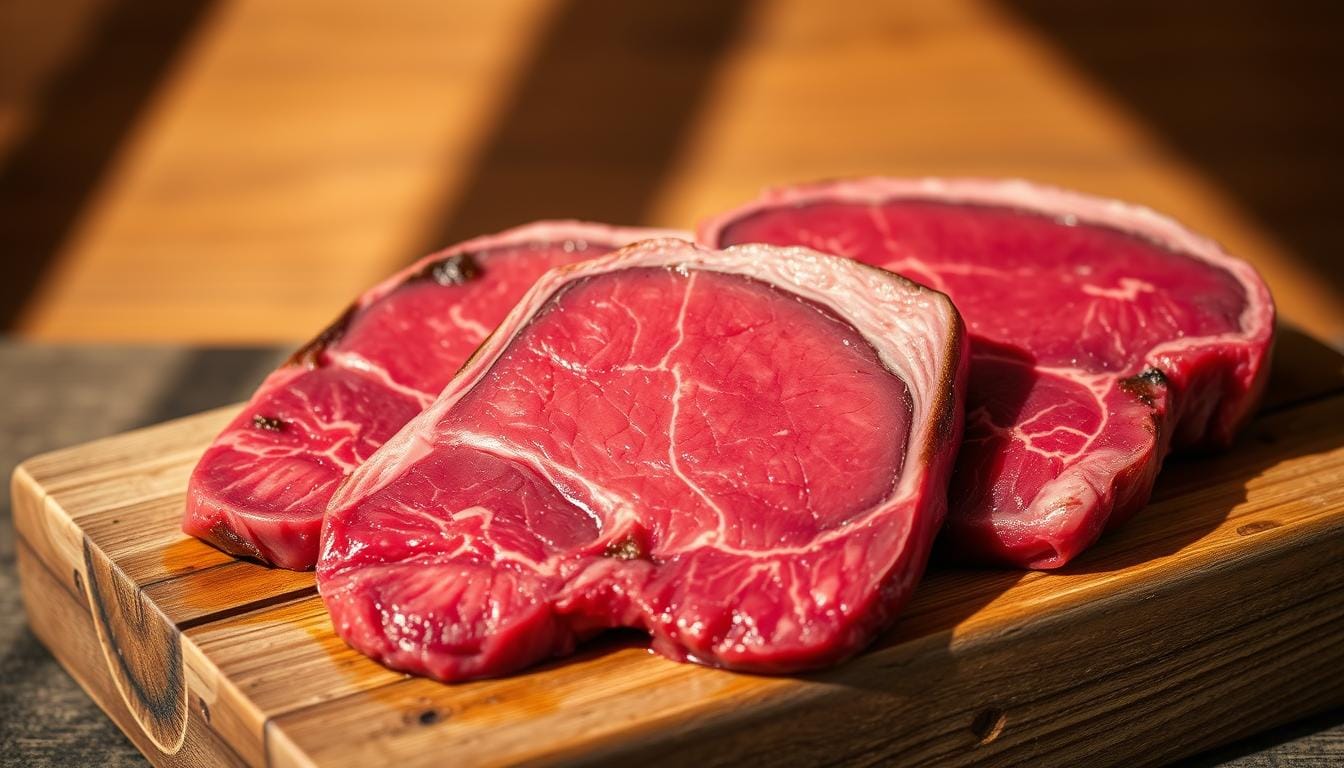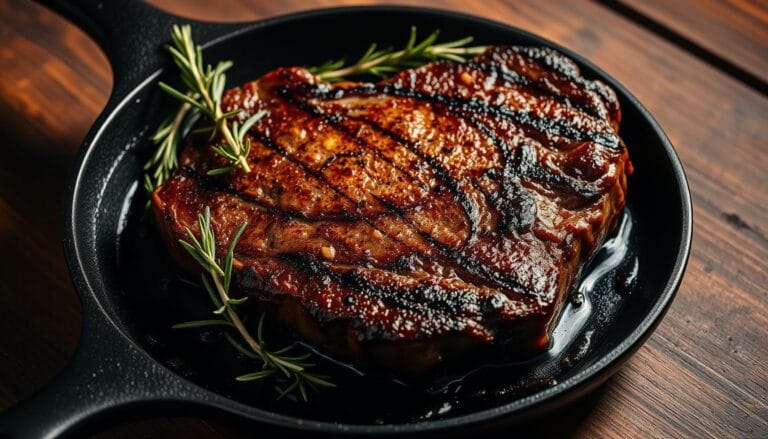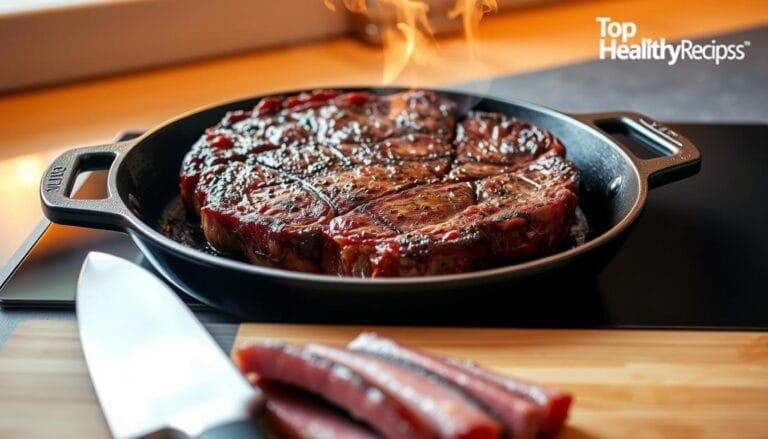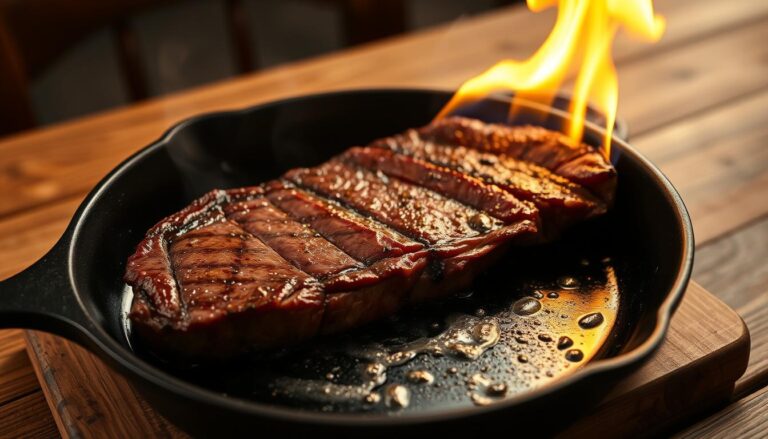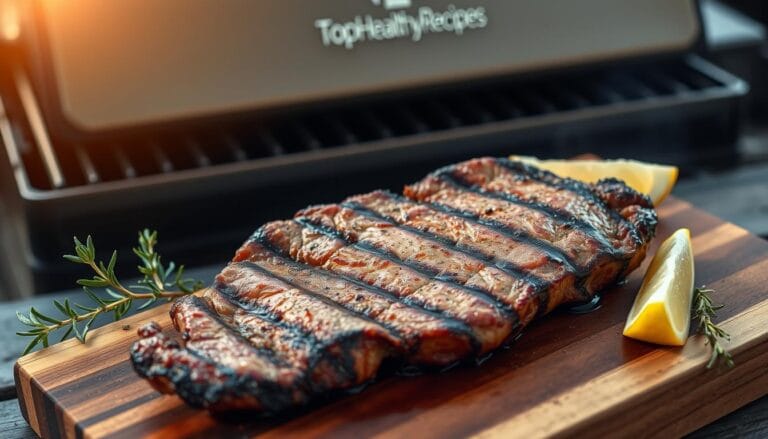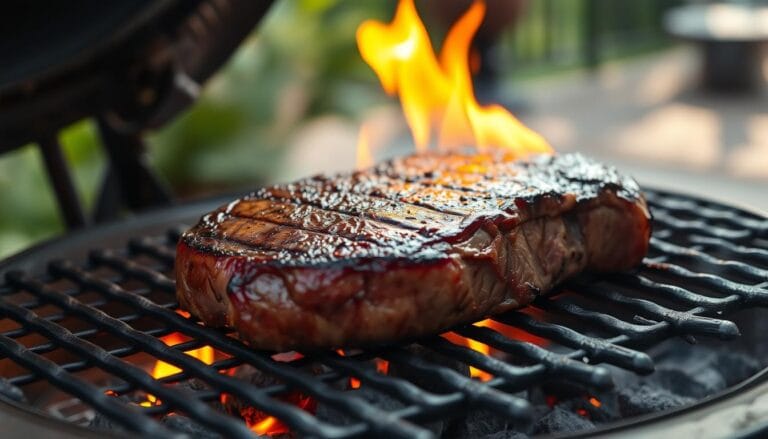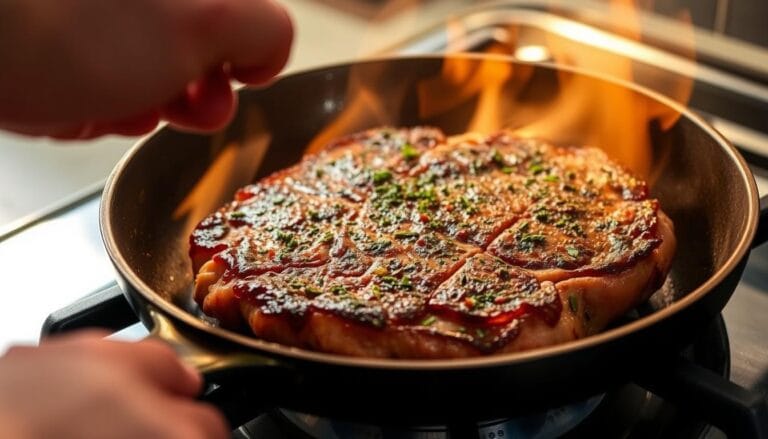Picanha Beef Cut Guide: Taste the Most Underrated Steak Ever
Table of Contents
Picanha Beef Cut Guide: Taste the Most Underrated Steak Ever
Are you ready to try a juicy steak with a unique taste? Imagine a steak that’s both tender and full of flavor. This is what picanha offers, a Brazilian favorite that’s becoming popular everywhere.
So, what’s so special about picanha? It’s the fat cap that makes it stand out. This fat cap makes the steak tender and boosts its flavor. Unlike other steaks, picanha gives you a taste experience like no other.
Key Takeaways
- Discover the unique characteristics of the picanha beef cut.
- Learn how to select the best picanha steaks for your next meal.
- Understand the importance of the fat cap in picanha.
- Explore different ways to prepare and cook picanha to perfection.
- Uncover why picanha is considered one of the most underrated steaks.
What is Picanha Beef Cut?
Picanha is a unique and tasty beef cut. It comes from the top of the rump. This cut has a thick fat cap that makes it tender and flavorful.
Overview of Picanha
Picanha is from the top sirloin, known as the rump cap or coulotte. It weighs 2-3 pounds. It has a thick fat cap on one side.
This fat cap is key to its flavor. It melts while cooking, adding rich, savory tastes. In the U.S., it might be called top sirloin cap or coulotte.
Picanha is special because of its anatomy. It has a lot of marbling, which is fat inside the meat. This makes it tender and flavorful, loved by beef lovers.
Traditional Uses in Cuisine
Picanha is a favorite in Brazilian churrasco and South American dishes. It’s cut into thick steaks, seasoned with coarse salt, and grilled. This brings out its natural taste.
In Brazilian barbecues, picanha is grilled on skewers. It’s served until everyone is full. The simple cooking lets the meat’s quality and flavor stand out.
| Traditional Preparation Methods | Description |
|---|---|
| Cutting into C-shaped Steaks | Picanha is cut into thick steaks to preserve its tenderness and flavor. |
| Seasoning with Coarse Salt | A simple seasoning that enhances the natural flavors of picanha. |
| Grilling over Open Flames | Grilling adds a smoky flavor and a charred texture to the picanha. |
The Origin of Picanha
Did you know that picanha, a favorite in Brazilian steakhouses, has a rich history? It’s deeply rooted in Brazil’s culture and food traditions.
Historical Background
The word “picanha” comes from old Brazilian Portuguese. It means the tip of the rump cap, a prized beef cut. This cut was loved for its tenderness and flavor.
The history of picanha is tied to Brazil’s cattle ranching. It was valued for its quality.
Butchering traditions vary worldwide, affecting meat appreciation. In Brazil, picanha is celebrated, unlike in some places. This difference stems from history and culture.
Cultural Significance in Brazil
In Brazil, picanha is the star of churrasco, or Brazilian barbecue. It’s a key part of family gatherings and celebrations. Sharing picanha shows Brazilian hospitality and food traditions.
Churrascarias, or Brazilian steakhouses, have helped spread picanha’s fame globally.
Picanha’s importance in Brazil is seen at big life events and celebrations. It brings people together, symbolizing community and warmth. As Brazilian food becomes more popular, picanha is gaining global recognition for its flavor and tenderness.
How to Select the Best Picanha
Knowing what makes a great picanha beef cut is key for steak fans. At the butcher shop or specialty meat market, knowing what to look for is vital. It can make your picanha steak delicious.
Identifying Quality Cuts
A quality picanha is triangular in shape and weighs 2-3 pounds. It should be 2-3 inches thick at its thickest part. A great picanha has a fat cap.
The fat cap should be intact and evenly spread, about 1/4 to 1/2 inch thick. This fat cap is key as it melts during cooking. It adds flavor and tenderness to the steak. Look for a bright cherry red color, which means it’s fresh and of high quality.
What to Look for in Marbling
Picanha steaks have some marbling, but it’s not as important as with other cuts like ribeye. The fat cap is where most of the flavor comes from, not the intramuscular fat. But, some white fat streaks in the meat are good as they add to the flavor and juiciness.
When picking picanha, look at the grading: Prime, Choice, or Select. Prime has the most marbling, Choice is a good middle ground, and Select is leaner. For picanha, the fat cap quality is more important than the grade. But, a higher grade usually means better quality.
| Grade | Marbling | Fat Cap Quality |
|---|---|---|
| Prime | Abundant | High |
| Choice | Moderate | Good |
| Select | Less | Variable |
By knowing these details, you can pick the best picanha beef cut for your next meal. This ensures a great dining experience.
Preparing Picanha for Cooking
Preparing picanha for cooking is a few steps that can make your meal better. Whether you’re a pro in the kitchen or new to cooking, knowing how to prepare this beef is key. It helps you get the best taste and texture.
Essential Preparation Steps
Before you start cooking, prepare the picanha right. First, think about the fat cap. It’s good to keep it on, but trimming it to 1/4 to 1/2 inch helps cook evenly. Scoring the fat in a crosshatch pattern helps the fat melt and keeps the meat flat.
Key Preparation Steps:
- Trim the fat cap to an even thickness if necessary
- Score the fat cap in a crosshatch pattern
- Clean and dry the meat thoroughly
- Bring the picanha to room temperature before cooking
Letting the picanha warm up to room temperature, 30 to 60 minutes before cooking, helps it cook better. You can cook it whole for a stunning look or cut it into steaks for easier serving and even cooking.
Recommended Seasonings and Marinades
Seasoning picanha is where you can get creative. The traditional Brazilian way is with coarse sea salt to highlight the meat’s natural taste. But, you can try different seasonings and marinades to make it your own.
Simple yet effective seasonings include:
- Garlic and black pepper
- Herbs like thyme or rosemary
- Citrus-based marinades for a brighter flavor
For a unique taste, a marinade can be a great choice. Mix olive oil, minced garlic, and herbs, rub it on the meat, and marinate for a few hours or overnight.
| Seasoning/Marinade | Description | Application Time |
|---|---|---|
| Coarse Sea Salt | Traditional Brazilian seasoning | Just before cooking |
| Garlic and Black Pepper | Simple and flavorful | 30 minutes before cooking |
| Citrus Marinade | Brightens the flavor | 2-4 hours or overnight |
Culinary experts say, “The key to seasoning picanha is to complement its natural flavor without overpowering it.” Keeping it simple often brings out the best in this exceptional cut of beef.
“The beauty of picanha lies in its rich flavor and tender texture, making it a versatile canvas for various seasonings and cooking techniques.” – Chef’s Guide
Cooking Methods for Picanha
To get the most out of picanha, it’s key to know how to cook it. Picanha is known for its rich taste and soft texture. It can be cooked in different ways, each giving a unique taste experience.
Grilling the Perfect Picanha
Grilling is the best way to cook picanha. It gives a crispy outside and a juicy inside. Start by setting up a two-zone fire for searing and cooking.
Place the fat cap down to melt some fat. Then, sear all sides before cooking on indirect heat. This method adds a smoky taste, great with charcoal.
Keep the temperature between 130°F – 135°F for medium-rare. Use tongs to turn the picanha and watch for flare-ups. Brazilians grill it on skewers, folded in a C-shape, for even cooking and a nice look.
Oven Roasting Techniques
Oven roasting is a good choice when grilling isn’t an option. The reverse sear method works well: roast at 225-250°F until it’s 110-115°F inside. Then, sear it in a hot pan for a crispy crust.
Put the picanha on a rack in a roasting pan for air to circulate. Start with the fat side up for a crispy cap. Use a meat thermometer to check the temperature.
Pan-Seared Picanha Tips
Pan-searing is perfect for small portions or when you can’t grill or roast. Heat a heavy pan over high heat with oil to prevent sticking. Sear the picanha on all sides, then lower the heat to finish cooking.
The sear-and-baste method adds flavor: baste with butter, garlic, and herbs during cooking. For thicker cuts, finish in the oven after searing for even cooking.
Recommended Picanha Cooking Temperatures
To enjoy picanha at its best, knowing the right internal temperatures is key. Cooking it to the correct temperature keeps it tender and flavorful.
Ideal Internal Temperature Levels
The ideal internal temperature for picanha depends on how you like it cooked. Here’s a guide:
| Doneness Level | Internal Temperature (°F) |
|---|---|
| Rare | 125 |
| Medium-Rare | 130-135 |
| Medium | 140-145 |
| Medium-Well | 150-155 |
| Well-Done | 160+ |
Medium-rare to medium is often the best for picanha. It’s tender and full of flavor. Remember, the temperature will rise a bit after you take it off the heat. So, aim to remove it when it’s 5-10°F below your target.
Tips for Using a Meat Thermometer
A meat thermometer is essential for cooking picanha right. There are many types, like instant-read digital, leave-in probe, and wireless smart thermometers. Each has its own benefits for tracking picanha’s temperature.
- Instant-read digital thermometers give quick and precise readings.
- Leave-in probe thermometers let you keep an eye on the temperature without opening the oven or grill.
- Wireless smart thermometers make it easy to check the temperature from afar.
When using a thermometer, insert it into the thickest part of the meat. Make sure it’s not touching fat, bone, or the cooking surface. Taking multiple readings helps ensure you get an accurate temperature, which is important for picanha’s uneven shape.
Serving Suggestions for Picanha
To enjoy picanha fully, think about what goes with it. It’s not just about the steak. It’s about making a great meal.
Accompaniments and Side Dishes
Picanha is rich and tasty. It goes well with many sides. Brazilian dishes are perfect for this.
- Farofa: Toasted cassava flour adds crunch and a nutty taste that goes well with beef.
- Vinagrete: A fresh tomato salsa from Brazil, it’s tangy and contrasts the beef’s richness.
- Rice and Beans: A Brazilian favorite, they offer a comforting base for picanha’s bold flavors.
- Grilled Vegetables: Bell peppers, zucchini, and asparagus add color and variety to your plate.
There are also other sides that go great with picanha. Try:
- Chimichurri Sauce: A tangy Argentinean sauce with parsley, garlic, and vinegar.
- Roasted Garlic Mashed Potatoes: Creamy potatoes with roasted garlic soak up picanha’s juices.
- Simple Green Salad: A light salad with a tangy dressing cuts through the meal’s richness.
Ideal Wine Pairings
Picanha needs a full-bodied red wine. Here are some great choices:
- Brazilian Tannat or Cabernet Sauvignon: These wines from Vale dos Vinhedos match picanha’s bold flavor.
- Argentine Malbec: Its fruitiness and smooth tannins pair well with picanha.
- Chilean Carmenere: Offers fruitiness and spice that complements the beef.
- Portuguese Douro Reds or Spanish Tempranillo: These wines have complex flavors and balanced tannins.
If you prefer beer, dark lagers, amber ales, or stouts work well with picanha. Remember to serve wine at the right temperature and consider decanting.
Common Mistakes to Avoid When Cooking Picanha
Learning how to cook picanha starts with knowing what can go wrong. Cooking this meat needs careful attention to get it right. The biggest mistakes are overcooking and undercooking, which can ruin the dish.
Overcooking and Undercooking
Overcooking makes picanha tough and dry because the fat melts away. Undercooking, on the other hand, can leave parts of the meat raw. To fix this, it’s key to control the cooking temperature and time.
- Use a Meat Thermometer: This tool is invaluable for ensuring your picanha is cooked to the right internal temperature.
- Strategic Placement: Place thicker portions of the picanha on the grill or in the oven where they can receive more even heat.
- Butterfly Cutting: For very thick portions, consider butterfly cutting to help achieve more uniform cooking.
Neglecting Resting Time
Resting picanha after cooking is key. It lets the meat relax and soak up juices, making it juicier and tastier. The rest time depends on the picanha’s size; a whole one needs 10-15 minutes, while steaks need 5-7 minutes.
To keep the picanha warm while it rests, cover it with foil. This keeps it at a good temperature without drying out. Not resting the meat can cause it to lose a lot of juice, making it dry and less tasty.
By avoiding these common mistakes, you can improve your picanha cooking. Whether grilling, roasting, or pan-searing, paying attention to temperature, cooking time, and resting is essential.
Cutting Techniques for Picanha
Learning to cut picanha right is key for a great meal. The way you slice it affects its texture and taste. Whether it’s for a barbecue or a fancy dinner, knowing how to cut is vital.
How to Slice Picanha Correctly
There are two ways to slice picanha: before or after cooking. Each method has its benefits, depending on what you like and the event.
For cuts before cooking, make C-shaped steaks by cutting across the grain. These should be 1-1.5 inches thick. This method cooks evenly and is good for big groups.
Key steps for pre-cooking cuts:
- Identify the grain direction
- Cut across the grain into 1-1.5 inch thick steaks
- Ensure each steak has a portion of the fat cap
For slicing after cooking, cook the picanha whole and then slice it thinly. This makes it tender and juicy.
Steps for post-cooking slicing:
- Cook the picanha whole to your desired level of doneness
- Let it rest for a few minutes before slicing
- Slice into thin (1/4 to 1/2 inch) portions against the grain
Importance of the Grain Direction
Knowing the grain direction is essential when cutting picanha. Cutting against the grain makes the meat tender. This is because it shortens the muscle fibers.
To find the grain direction, look at the lines on the meat’s surface. These lines might be hard to see in picanha, but they’re clearer after cooking.
Tips for identifying grain direction:
- Examine the surface of the picanha before and after cooking
- Look for the lines or striations indicating muscle fiber direction
- Adjust your slicing direction to cut against the grain
By learning to cut picanha and understanding grain direction, you’ll serve a tender and tasty dish. This showcases the best of this special beef cut.
Variations of Picanha
Picanha has inspired chefs globally to try new recipes and methods. This Brazilian cut has been reimagined in many ways. It shows how versatile and flavorful picanha can be.
Picanha Recipes Around the World
Picanha has traveled the world, leading to many different recipes. In Portugal, it’s cooked with bay leaves and garlic for a special aroma. In Argentina, chimichurri sauce is a favorite for seasoning picanha, adding a tangy taste. In North America, chefs use smoking and complex rubs to give it a unique flavor.
Some notable variations include:
- Picanha na Chapa: Grilled on a flat top with onions, this method brings out the tender qualities of the meat.
- Picanha Sandwich: A popular street food adaptation, where picanha is thinly sliced and served in a crusty bread roll.
- Picanha Stew: A hearty variation where picanha is slow-cooked with vegetables, creating a comforting and flavorful stew.
Regional Differences in Preparation and Serving
In Brazil and South America, different regions have their own ways of cooking picanha. In the south, where churrasco started, picanha is grilled over an open flame. This highlights its natural taste. But in places like Rio de Janeiro and São Paulo, they use ovens and pans for different flavors.
| Region | Preferred Cooking Method | Common Accompaniments |
|---|---|---|
| Southern Brazil | Open flame grilling | Farofa, grilled vegetables |
| Rio de Janeiro | Oven roasting | Black beans, rice |
| São Paulo | Pan-searing | Grilled pineapple, sautéed greens |
As picanha becomes more popular worldwide, its cooking methods are changing. Chefs mix traditional and new ways of cooking. This variety offers many picanha experiences for fans to try.
Nutritional Information of Picanha
Picanha is not just tasty; it’s also packed with nutrients. Knowing what Picanha is and its nutritional value helps you choose better foods.
Caloric Value and Macronutrients
A 4oz serving of Picanha without fat has about 250-300 calories. This makes it a lean protein choice. But, adding the fat cap boosts calories a lot. Picanha has a lot of protein, around 25-30g per 4oz.
The fat in Picanha includes saturated, monounsaturated, and polyunsaturated fats. Whether you trim or keep the fat cap changes its nutritional value. It’s important to think about your diet needs.
Benefits of Including Picanha in Your Diet
Picanha is full of important nutrients. It’s rich in B vitamins like B12, B6, and niacin. These vitamins help with energy and body functions.
Picanha also has minerals like iron, zinc, selenium, and phosphorus. These support your immune system and overall health.
Picanha is great for many diets. It works well in protein-focused, low-carb, or balanced diets. Choosing between grass-fed and grain-fed Picanha depends on your diet preferences.
Remember to eat Picanha in moderation. Aim for 4oz to 6oz servings. This way, you enjoy its benefits without overeating.
Comparing Picanha with Other Beef Cuts
Exploring the differences between Picanha and other beef cuts can make your meals better. It’s key to compare Picanha with Ribeye and Sirloin when choosing steaks.
How Picanha Compares to Ribeye
Picanha and Ribeye are top-notch cuts, but they differ. Ribeye is famous for its rich, buttery taste from its marbling. Picanha, on the other hand, has a clean beef flavor and a fat cap that makes it tender and tasty.
- Anatomical Location: Ribeye comes from the rib section, while Picanha is cut from the top sirloin cap.
- Fat Distribution: Ribeye has internal marbling, whereas Picanha features an external fat cap.
- Flavor Profile: Ribeye offers a rich, buttery taste, while Picanha provides a cleaner, beefier flavor.
- Texture: Picanha is typically firm yet tender, whereas Ribeye is often softer and juicier due to its marbling.
Choosing between Picanha and Ribeye depends on your taste and texture preferences. If you like a richer taste, go for Ribeye. For a cleaner beef flavor and great texture, Picanha is a great pick.
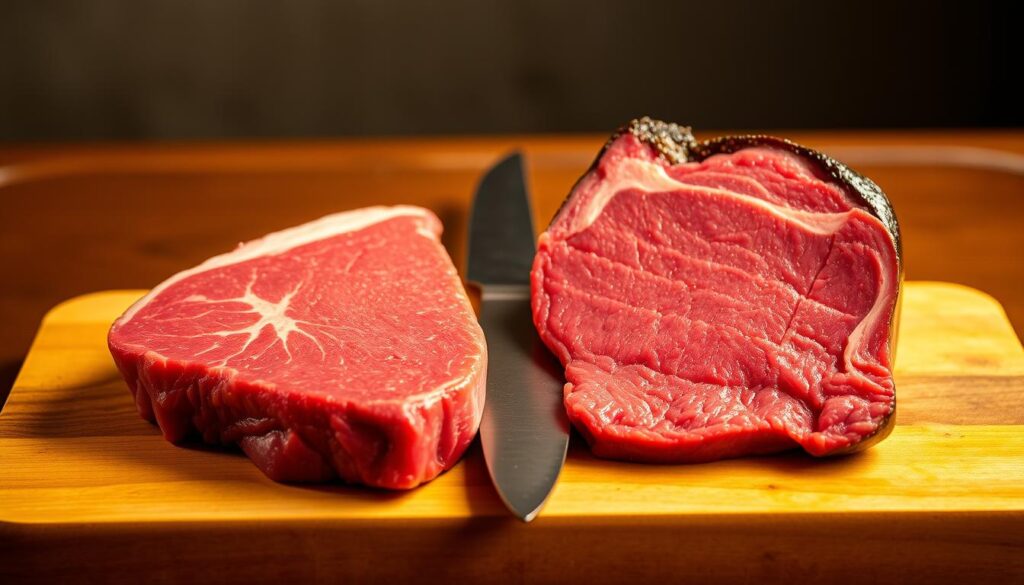
Picanha vs. Sirloin: A Comparison
Picanha is part of the sirloin, but it’s different from other sirloin cuts. Let’s look at how Picanha compares to top sirloin, bottom sirloin, and sirloin tip.
| Cut | Tenderness | Fat Content | Best Cooking Method |
|---|---|---|---|
| Picanha | High | External fat cap | Grilling |
| Top Sirloin | Medium | Lean | Pan-searing |
| Bottom Sirloin | Medium to Low | Variable | Oven Roasting |
| Sirloin Tip | Medium | Lean | Stir-frying |
Picanha is known for its tenderness and unique fat cap, perfect for grilling. While other sirloin cuts are tasty, they can’t match Picanha’s tenderness and flavor.
In conclusion, when comparing Picanha to other beef cuts like Ribeye and Sirloin, think about flavor, texture, and cooking methods. Picanha’s special qualities make it a top choice for those eager to try something new in premium steaks.
Where to Buy Picanha in the United States
Looking to cook picanha? First, find a reliable source. This could be a local butcher or an online meat supplier. Picanha is known for its rich flavor and tender texture. It’s a favorite among steak lovers and is becoming more available in the U.S.
Finding a Local Butcher
Finding a local butcher with picanha can be tough. Start by visiting specialty butcher shops, focusing on South American or international meats. They’re more likely to have picanha or order it for you. Call ahead to check availability, as “picanha” might not be well-known. Instead, ask for “top sirloin cap,” “coulotte,” or “rump cap.”
When checking picanha quality at a local shop, consider these points:
- Marbling: Look for fat throughout the meat for better flavor and tenderness.
- Aging: Ask if the picanha is dry-aged to enhance its taste.
- Sourcing: Find out where the beef comes from, as some may offer grass-fed or specialty options.
| Butcher Shop Characteristics | Ideal Features |
|---|---|
| Meat Quality | High marbling, dry-aged |
| Sourcing | Grass-fed, local farms |
| Customer Service | Knowledgeable staff, willing to order specific cuts |
Online Retail Options
Shopping online is convenient if you can’t find picanha locally. Sites like Snake River Farms, Porter Road, and Crowd Cow sell high-quality picanha. When ordering online, consider these factors:
- Weight and Cut: Make sure you can buy the right amount, and check if the picanha comes with or without fat.
- Aging and Grading: Look for details on aging and USDA grading.
- Shipping: Check how the meat is kept cool during shipping, like with dry ice, and the delivery time.
When comparing online retailers, look at more than just price. Consider the product quality, customer reviews, and the retailer’s transparency about sourcing and production. Some may offer extra services like custom cutting or recipe suggestions.
By checking both local butchers and online retailers, you can find great picanha. Whether you’re an experienced chef or just starting, getting the right picanha is key to a great meal.
Price Range for Picanha Cuts
Picanha, a top-notch beef cut, has a price range that changes based on several factors. These factors include the quality, source, and type of picanha. So, when you’re shopping for picanha, you’ll find prices vary a lot.
Understanding Price Variability
The price of picanha changes because of different cattle breeds, raising methods, and USDA grades. For example, Wagyu picanha costs more than regular picanha. This is because Wagyu cattle have special genetics and are fed differently.
Here’s a quick look at the average prices for different picanha types:
| Type of Picanha | Average Price Range (per pound) |
|---|---|
| Conventional Picanha | $15-$25 |
| Choice Picanha | $20-$35 |
| Prime Picanha | $30-$50 |
| Wagyu Picanha | $50-$100 |
| Grass-fed Picanha | $25-$40 |
Factors Affecting Cost
Many things affect picanha’s price, like aging, supply chain, and demand. Dry-aging, for instance, makes picanha more expensive. This is because it’s a time-consuming process and some product is lost during aging.
Also, importing picanha from places like Brazil can raise the price. This is due to tariffs, shipping costs, and other logistical issues. As more people want picanha, prices might change based on market demand.
Tips for Storing Leftover Picanha
After enjoying a tasty picanha steak, you might wonder how to store leftovers. Storing them right is key to keeping the meat fresh and safe.
Best Practices for Refrigeration
Cool the leftover picanha to room temperature within two hours of cooking. This step stops bacteria from growing and keeps the meat fresh.
- Wrap the picanha tightly in plastic wrap or aluminum foil to prevent oxidation and moisture loss.
- Place the wrapped picanha in an airtight container to add an extra layer of protection.
- Store the container on the lower shelves of your refrigerator where the temperature is most consistent.
Refrigerated picanha stays best for 2-3 days. It’s safe to eat for 3-4 days, but the quality might drop. Always check for spoilage before eating.
| Storage Method | Duration | Quality |
|---|---|---|
| Refrigeration | 2-3 days | Peak quality |
| Refrigeration | 3-4 days | Safe to eat, but quality may degrade |
Reheating Strategies Without Drying Out
Reheating leftover picanha can be tricky. Traditional methods often make the meat dry. But, there are ways to keep it juicy and flavorful.
Using a sous vide machine is one effective method. Place the picanha in a sous vide bag and heat it at 130-135°F. This method ensures even heating and keeps moisture in.
“Sous vide reheating is a game-changer for leftover picanha. It maintains the tenderness and flavor, making it almost as good as when it was first cooked.”
Other methods include low-and-slow oven reheating at 250°F with added moisture, microwave reheating at lower power with moisture protection, and stovetop reheating in a skillet with added fat.
- Low-and-slow oven: Wrap the picanha in foil with some stock or sauce and heat for 10-15 minutes.
- Microwave: Cover the picanha with a microwave-safe lid and heat on lower power for short intervals, checking frequently.
- Stovetop: Slice the picanha thinly, add some fat to a skillet, and reheat gently, stirring frequently.
If reheating seems too hard, think about using leftover picanha in cold sandwiches, salads, or soups and stews.
Picanha: A Crowd-Pleaser for Any Occasion?
Picanha is becoming a favorite steak for those who want to impress at parties. It’s perfect for backyard barbecues, dinner parties, or big gatherings. Its rich flavor and unique look make it a standout choice.
Perfect for BBQs and Gatherings
Picanha’s presentation is impressive, making it a great centerpiece for meals. Serving it on skewers adds excitement to your event. It’s also easy to cook, allowing you to serve it at different doneness levels.
Plan your picanha serving size based on your guests’ appetites. Aim for 6-8 ounces per person for a main course. Remember, picanha tastes best when served fresh.
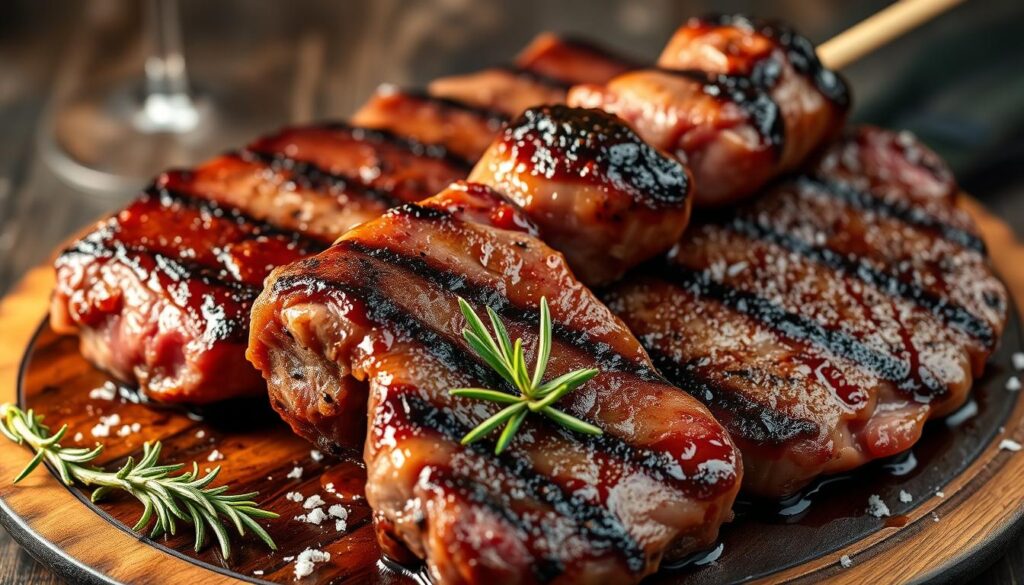
Impressing Guests with a Unique Cut
Serving picanha is more than just food; it’s an experience. Share its history and cultural significance to spark conversations. Carving it tableside or serving on skewers adds drama.
Offer both fatty and lean pieces to please everyone. Pair it with the right wine and sides for a memorable meal. A buffet with picanha as the main attraction is a great way to impress.
Highlight picanha’s unique qualities and the effort you put into preparing it. This shows your dedication as a host. With its taste, presentation, and versatility, picanha is a crowd-pleaser.
Conclusion: Why You Should Try Picanha
Picanha beef cut is becoming more popular among steak lovers. It’s tender, flavorful, and has a special fat cap. This makes it stand out among other high-quality cuts.
Picanha is more than just beef. It’s a culinary journey into Brazilian cuisine. By learning about picanha and how to cook it, you can enjoy this rich cultural heritage at home.
The Picanha Advantage
Picanha offers a unique beef experience. It’s different from common American steak cuts. Its versatility lets you explore various cooking traditions, from traditional Brazilian to new recipes.
Get Started with Picanha
To begin, try grilling or oven-cooking picanha with just salt. As you get more comfortable, you can try different marinades and cooking methods, like pan-searing.
Picanha is easy to work with and of high quality. It’s sure to wow your guests and become a favorite. So, why not join the picanha enthusiasts and discover its delight for yourself?
FAQ
What is picanha beef cut?
How do I cook picanha?
What is the ideal internal temperature for cooking picanha?
How do I slice picanha correctly?
Can I buy picanha online?
How should I store leftover picanha?
How do I reheat leftover picanha without drying it out?
What are some good side dishes to serve with picanha?
What wine pairs well with picanha?
Is picanha a good choice for entertaining?
For more cooking tips, stay connected with us. We also recommend the cookbook Skinnytaste Simple: Easy, Healthy Recipes with 7 Ingredients or Fewer
For more Recipes about Steak ?
Did You try our recipe ?
There are no reviews yet. Be the first one to write one.
